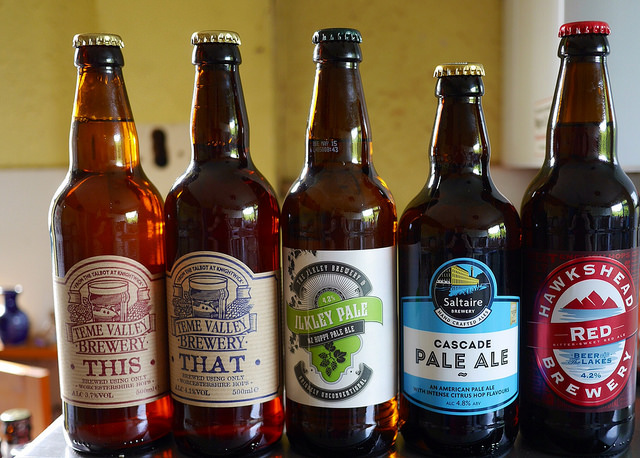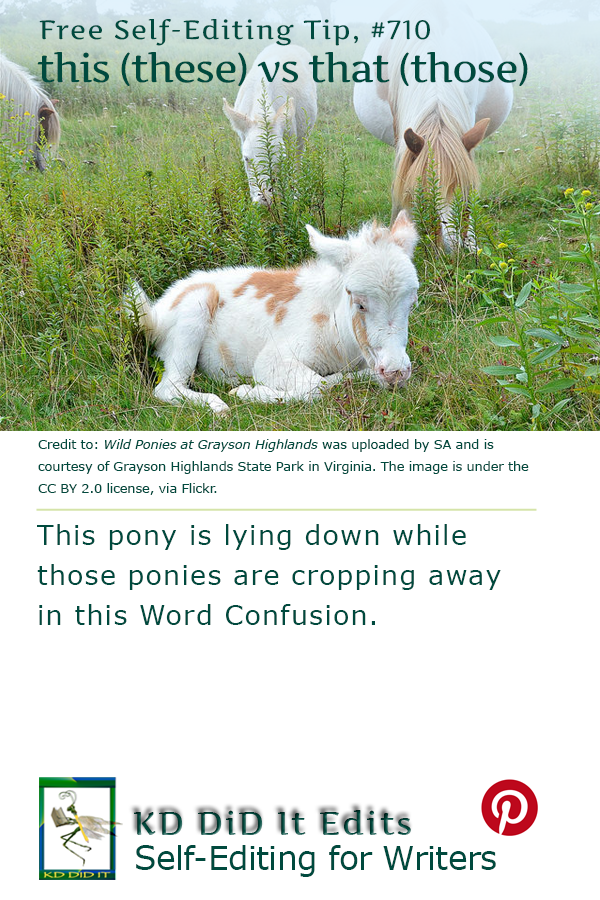Revised as of
4 Jan 2023
A little a’dis, a little a’dat, and we’ll have a nice rabbit pie to go with our beer.
Can you tell I haven’t had lunch yet?
This post, as opposed to those posts previously published, is all about the near and far of this and that . . . along with their plural forms, these and those.
And yes, it’s a good idea to understand the differences, if only so you can “spit in the eye of the rules” when you want to manipulate these words to create a particular dialect for one of your characters. How you use this/these and that/those can provide a subtle indication of higher or lower education without your having to tell the reader.
Know that that is quite flexible and can be omitted when introducing a subordinate clause and can be used to reference both humans and nonhuman objects or places.
While this post is primarily interested in the demonstrative adjective and pronoun aspect of this vs that, its other grammar categories are included. You may also want to explore the post on “Which is That?” to better understand when to use that or which.
Word Confusions . . .
. . . started as my way of dealing with a professional frustration with properly spelled words that were out of context in manuscripts I was editing as well as books I was reviewing. It evolved into a sharing of information with y’all. I’m hoping you’ll share with us words that have been a bête noire for you from either end.
If you found this post on “This (These) versus That (Those)” interesting, consider subscribing to KD Did It, if you’d like to track this post for future updates.
| This (These) | That (Those) |
|---|---|

This, That and Some Other Beers by Smabs Sputzer is under the CC BY 2.0 license, via Flickr. — These beers look good. |

Hand Pumped Beers © Richard Hoare is under the CC BY-SA 2.0 license, via Geograph.uk. — Yeah, but what about those beers over there? |
| Part of Grammar: | |
| Adverb; Demonstrative adjective; Demonstrative pronoun; Determiner Plural for demonstratives and determiner: these |
Adverb; Conjunction; Demonstrative adjective; Demonstrative pronoun; Determiner; Relative pronoun Plural for demonstratives, determiner, and relative pronoun: those |
| Refers to a person or object that is here / near.
Refers to an action that is near in time. |
Refers to a person or object that is there / far.
Refers to an action that has finished or is in the past. |
| Adverb: [Used with adjectives and adverbs of quantity or extent] To specify a precise degree that is about to be mentioned |
Adverb: [Used with adjectives and adverbs of quantity or extent] To such an extent or degree
[Dialect; used to modify an adjective or another adverb] To such an extent Conjunction:
[Literary; usually with modal] Expressing a wish or regret |
| Demonstrative adjective: Shows the relative distance between the speaker and the noun/pronoun, and the demonstrative adjective must agree with the noun/pronoun. Used to indicate a person, place, thing, or degree as present, near, just indicated or mentioned, or as well-known or characteristic Used to indicate the nearer in time, place, or thought of two persons, things, etc. Used to imply mere contradistinction (as opposed to that) Used in place of an indefinite article for emphasis |
Demonstrative adjective: Shows the relative distance between the speaker and the noun/pronoun, and the demonstrative adjective must agree with the noun/pronoun. Used to indicate a person, place, thing, or degree as in the past, far, previously indicated or mentioned, or as well-known or characteristic Used to indicate the further in time, place, or thought of two persons, things, etc. Used to imply mere contradistinction (as opposed to this) Used in place of an indefinite article for emphasis Used as the object of a preposition, with the preposition standing at the end of a relative clause Used in various special or elliptical constructions |
| Demonstrative pronoun: Shows the relative distance between the speaker and the verb or by themselves. Used to identify a specific person, thing, idea, state, event, time, remark, etc., close at hand or being indicated or experienced
Used to indicate a person, thing, idea, state, event, time, remark, etc., by way of emphasis Referring to a specific thing or situation just mentioned or pointed out What is about to follow Used to indicate one of two or more persons, things, etc., referring to the one nearer in place, time, or thought (as opposed to that) Used to indicate one of two or more persons, things, etc., implying a contrast or contradistinction (as opposed to that) |
Demonstrative pronoun: Shows the relative distance between the speaker and the verb or by themselves. Used to identify a specific person or thing observed by the speaker
Referring to a specific thing previously mentioned, known, or understood [Often with clause] Used in singling out someone or something and ascribing a distinctive feature to them |
| Determiner: Used to identify a specific person or thing close at hand or being indicated or experienced
Referring to a specific thing or situation just mentioned Used with periods of time related to the present
[Informal; chiefly in narrative] Used to refer to a person or thing previously unspecified |
Determiner: Used to identify a specific person or thing observed or heard by the speaker
Referring to a specific thing previously mentioned, known, or understood [Usually with clause] Used in singling out someone or something and ascribing a distinctive feature to them Referring to a specific person or thing assumed as understood or familiar to the person being addressed Relative pronoun: |
| Examples: | |
| Adverb: We can only go this far. No, play it this softly. They can’t handle a job this big. He’s not used to this much attention. Go just this fast and you’ll be safe. |
Adverb: I would not go that far. It was that big, perhaps even bigger. The fish was that big. He wasn’t that far away. It’s not that important. He was that weak he could hardly stand. Conjunction: It is possible that we have misunderstood. He seemed pleased that I wanted to continue. She was so tired that she couldn’t think. We pray that the coming year may be a year of peace. I eat that I may live. Oh, that he could be restored to health. |
| Demonstrative adjective: “Hello, this is Peter.” Carol, this is my friend Simon. Simon, this is Carol. This person is my friend. These people are my friends. This problem has worried me for a long time. These problems have worried me for a long time. I was walking down the street when I heard this explosion. I was walking down the street when I heard these explosions. These shoes fit me very well. |
Demonstrative adjective: That party was boring. That city is busy. That flower is beautiful. Those flowers are beautiful. That book is old. Those books are old. Those boots are too expensive. That’s the farm that I spoke of. Fool that he is, I can’t help but love him. |
| Demonstrative pronoun: I’d like to buy this. I’d like to buy these. Is this your bag? Are these your bags? He soon knew that this was not the place for him. This is the captain speaking. This is my jacket. Those are my jackets. This is my shoe. These are my shoes. Listen to this record. Listen to these records. This is Liza and that is Amy. This is different from that. These are different from those. The company was transformed, and Ward had played a vital role in bringing this about. Now hear this! Watch this! |
Demonstrative pronoun: Did you do that? Which of those would you like? That’s his wife over there. Those are his wives over there. That is stronger than this. Those are stronger than these. That’s a good idea. Those are good ideas. What are we going to do about that? What are we going to do about those? It is part of human nature to be attracted to that which is aesthetically pleasing. His appearance was that of an undergrown man. They care about the rights of those less privileged than themselves. |
| Determiner: Don’t listen to this guy. Don’t listen to these guys. This croissant is delicious. These croissants are delicious. Should I take this one or that one? There was a court case resulting from this incident. There was a court case resulting from these incidents. I thought you were busy all this week. How are you this morning? I haven’t left my bed these three days. I turned around, and there was this big mummy standing next to us! I turned around, and there were these big mummies standing next to us! I’ve got this problem and I need help. I’ve got these problems and I need help. |
Determiner: Look at that man there. Look at those men over there. How much is that brush? How much are those brushes? He lived in Mysore at that time. He lived in Mysore at those times. Seven people died in that incident. Seven people died in those incidents. I have always envied that woman who makes her own bread. I have always envied those people who make their own bread. Where is that son of yours? Where are those sons of yours? Dad got that hunted look. Relative pronoun: That was the year that Anna was born. |
| Derivatives: | |
| Adjective: this-worldly | Adverb: thataway |
| History of the Word: | |
| Old English, as a neuter of thes, is of West Germanic origin and related to that and the. | Old English thæt, nominative and accusative singular neuter of se‘the’ is of Germanic origin and related to the Dutch dat and the German das. |
C’mon, get it out of your system, bitch, whine, moan . . . which words are your pet peeves? Also, please note that I try to be as accurate as I can, but mistakes happen or I miss something. Email me if you find errors, so I can fix them . . . and we’ll all benefit!
Satisfy your curiosity about other Word Confusions on its homepage or more generally explore the index of self-editing posts. You may also want to explore Book Layout & Formatting Ideas, Formatting Tips, Grammar Explanations, Linguistics, Publishing Tips, the Properly Punctuated, Writing Ideas and Resources, and Working Your Website.
Resources for This (These) versus That (Those)
Apple Dictionary.com
“Demonstrative Adjectives Examples.” SoftSchools.com. n.d. Web. n.d. <http://www.softschools.com/examples/grammar/demonstrative_adjectives_examples/98/>.
“This – That – These – Those.” Demonstratives. English Grammar Notes. Woodward English. n.d. Web. n.d. <http://www.grammar.cl/Notes/This_That_These_Those.htm>.
“What is a Demonstrative Adjective?” Grammar. YourDictionary.com. n.d. Web. n.d. <http://grammar.yourdictionary.com/parts-of-speech/adjectives/demonstrative-adjectives.html>.
Pinterest Photo Credits:
Wild Ponies at Grayson Highlands was uploaded by SA and is courtesy of Grayson Highlands State Park in Virginia. The image is under the CC BY 2.0 license, via Flickr.


